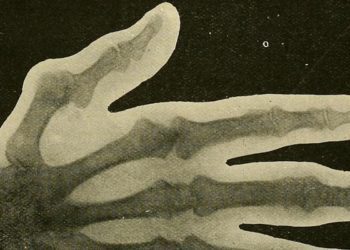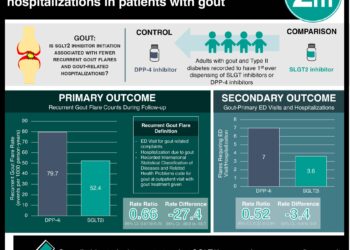Oral corticosteroids and NSAIDs similarly effective in the treatment of acute gout
1. In this randomized, control trial, oral prednisolone and indomethacin (NSAID) had similar analgesic effectiveness among patients with acute gout.
2. Participants did not report major adverse events during the study for either treatment.
Evidence Rating Level: 1 (Excellent)
Study Rundown: Gout, characterized by acute attacks of inflammation due to monosodium urate crystals, is the most prevalent form of inflammatory arthritis in men. Currently, the most widely accepted treatments of gout include nonsteroidal anti-inflammatory drugs (NSAIDs) and/or colchicine. Recent randomized control trials, however, indicate that oral corticosteroids may also serve as effective first-line agents for treatment. This study aimed to evaluate the equivalence in safety and pain reduction between corticosteroids (prednisolone) and NSAIDs (oral indomethacin) in the management of patients with gout. Similar analgesic effectiveness was observed between both NSAID and corticosteroid treatment. While neither participant groups reported adverse major events, patients in the indomethacin group reported more minor adverse events than those in the prednisolone group. This study is strengthened due to its large sample population and per protocol (PP) data analysis. However, it may be limited in its definition of gout, which was diagnosed based on clinical criteria rather than joint aspiration, suggesting that some enrolled patients may not have had gout. Overall, the study suggests that prednisolone may serve as an effective and safe first-line treatment option for acute gout.
Click to read the study published today in the Annals of Internal Medicine
Relevant Reading: Comparison of Oral Prednisolone/Paracetamol and Oral Indomethacin/Paracetamol Combination Therapy in the Treatment of Acute Goutlike Arthritis
In-Depth [randomized controlled trial]: In this double-blind, randomized control trial, 416 patients aged 18 years or older were selected from 4 different emergency departments in Hong Kong. All participants met several criteria for gout, including rapid onset of severe pain and erythema of an affected joint. Data were analyzed using a per protocol (PP) approach (patients who completed 2 weeks of follow-up) and intention-to-treat (ITT) approach (all randomly assigned patients). With respect to pain change, the difference in number of patients with a clinically meaningful decrease in pain score was not statistically significant between groups. Specifically, for patients at rest, the mean decrease in pain score was 6.54 mm/h (95%CI 5.02-8.06 mm/h) for indomethacin and 5.05 mm/h (95%CI 3.56-6.55 mm/h) for prednisolone. Likewise, during activity the mean decrease in pain score was 11.69 mm/h (95%CI 10.10-13.28 mm/h) for indomethacin and 11.38 mm/h (95%CI 9.98-12.79 mm/h) for prednisolone.
Image: CC/Wiki
©2016 2 Minute Medicine, Inc. All rights reserved. No works may be reproduced without expressed written consent from 2 Minute Medicine, Inc. Inquire about licensing here. No article should be construed as medical advice and is not intended as such by the authors or by 2 Minute Medicine, Inc.






![Nanoparticle delivery of aurora kinase inhibitor may improve tumor treatment [PreClinical]](https://www.2minutemedicine.com/wp-content/uploads/2016/02/20541_lores-75x75.jpg)